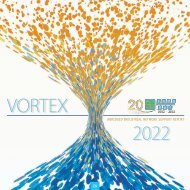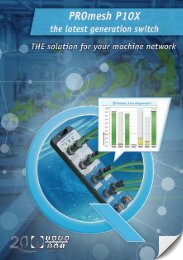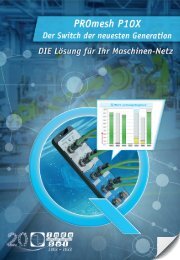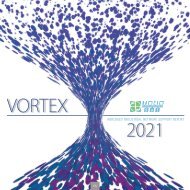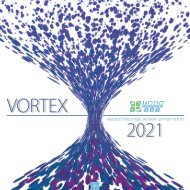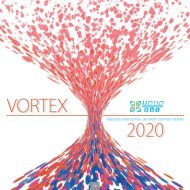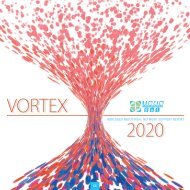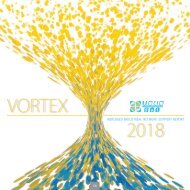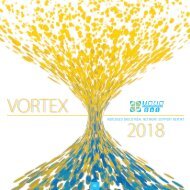Vortex Report 2017 - englisch
How does it go for our industrial networks? Are they already prepared for "industry 4.0"? An abridged report from global measurement calls delivers answers.
How does it go for our industrial networks? Are they already prepared for "industry 4.0"? An abridged report from global measurement calls delivers answers.
Create successful ePaper yourself
Turn your PDF publications into a flip-book with our unique Google optimized e-Paper software.
VORTEX<br />
ABRIDGED INDUSTRIAL NETWORK SUPPORT REPORT<br />
<strong>2017</strong><br />
EN
PREFACE<br />
Stable industrial networks despite high-speed communication?<br />
Dear customers,<br />
dear business partners,<br />
dear interested readers,<br />
Supermarket shelves always fully stacked, express packet delivery,<br />
fresh groceries every day – all a matter of course? In reality, these<br />
things are mainly a result of the hard work of a multitude of people<br />
in production, packaging, planning, and maintenance. However, industrial<br />
networks also ensure efficient workflows by providing a high<br />
degree of automation. Today, this infrastructure has to do more than<br />
just transmit process data: Intelligent sensors also report temperatures,<br />
filling levels, and other status information.<br />
This increasing data volume drives a continuous technological development<br />
process: In the late 1980s, the Interbus standard had a<br />
transmission rate of 500 kBit/s, and PROFIBUS had to breach the<br />
„sonic barrier“ of 1 Mbit/s in the 90s. By comparison, the 100 Mbit/s<br />
in PROFINET (2006) seem like a quantum leap. However, Time-Sensitive<br />
Networking (TSN) will soon be able to transmit several gigabits<br />
per second in real-time.<br />
As attractive as the benefits and opportunities of these high capacities<br />
may be, they also take the physical networks to their limits.<br />
The VORTEX <strong>Report</strong> <strong>2017</strong> investigates the question to what extent<br />
industrial networks are fit for these future challenges, what the problems<br />
are, and what the state of the art is in terms of prevention.<br />
These insights are based on data from 646 inspections conducted by<br />
technicians of Indu-Sol to determine the communication quality in<br />
industrial networks.<br />
Across all technologies, it became apparent that current equipotential<br />
bonding systems aren‘t up to the challenges posed by industrial<br />
networking and the increased use of higher-frequency power electronics.<br />
The existing standards and recommendations are becoming outdated<br />
and no longer reflect the reality in many areas of maintenance.<br />
A workgroup of the PROFIBUS & PROFINET international (PI) user<br />
organisation will therefore publish up-to-date recommendation of<br />
good practices for EMC and equipotential bonding in <strong>2017</strong>.<br />
Let us work together to shape technological change! We need to find<br />
our own solutions for new standards like TSN in automation, ensure<br />
security in the networked Industry 4.0 environment, and develop upto-date<br />
equipotential bonding systems. An assessment of the status<br />
quo, as provided by the VORTEX report, is a good starting point.<br />
With best regards<br />
René Heidl,<br />
Director of Technology & Support Indu-Sol GmbH<br />
2
KEY DATA<br />
Measurement calls and partners in 2016<br />
United Kingdom<br />
Benelux<br />
France<br />
Spain<br />
Switzerland<br />
Scandinavia<br />
Russia<br />
Poland<br />
Slovakia<br />
Austria<br />
Italy<br />
China<br />
South East Asia<br />
Brasilia<br />
Argentina<br />
2016: 178 Flight hours<br />
2015: 260 Flight hours<br />
2016: 3.849 Travel hours<br />
2015: 3.660 Travel hours<br />
h<br />
h<br />
2016: 392.756 Driven kilometres<br />
2015: 386.200 Driven kilometres<br />
km<br />
In addition to the 646 inspections conducted by Indu-Sol worldwide<br />
in 2016, a continuously growing network of international<br />
partners is developing. Their mission numbers – e.g. 33<br />
by Wito AG (Switzerland) or 25 by Control Specialists (UK)<br />
– show clearly that there is a global demand, and that services<br />
are being requested where they are available. With these local<br />
offers, we not only reduce travel time and mission duration<br />
but also help to maintain our customers‘ enjoyment of their<br />
automation solutions from Germany.<br />
3
TYPE OF CALL<br />
Maintenance, not repair: the idea behind the Delivery Concept<br />
With increasing frequency, owners of PROFIBUS systems that have<br />
been running for years find that their systems age and require more<br />
intensive maintenance in order to make it to the end of their planned<br />
lifetime. The number of PROFIBUS troubleshooting missions in the<br />
above graphic has increased again in 2016.<br />
As a result of these experiences, new networks are increasingly<br />
installed with measures to ensure long-term high communication<br />
quality. Under the name “Delivery Concept”, a combination of measurement<br />
and diagnostic functions with the attendant measurement<br />
of the communication quality in networks has become established in<br />
2016, taking a sizeable piece of the pie graphic on the side.<br />
Maintenance specialists appreciate having a documentation of the<br />
status quo at their disposal right from the start and being able to<br />
access current and historical status information. They are among<br />
the 5% that showed a decreasing share of troubleshooting missions<br />
last year compared with 2015. This effect is particularly visible in<br />
PROFINET networks, where the share of Delivery Concepts has been<br />
increasing steadily.<br />
The calibration verifies the quality of the system installation, and<br />
Permanent Network Monitoring provides stable operation in the long<br />
term. In 2016, about one in ten missions that were initially requested<br />
for calibration needed to be redeclared as troubleshooting missions.<br />
On the plus side, the elimination of defects during calibration<br />
ensured that networks were operating stable and without error right<br />
from the start.<br />
4
DIAGRAM<br />
Calibration, Troubleshooting and Delivery Concepts<br />
6 % of calibrations in the<br />
context of delivery concepts<br />
54 %<br />
troubleshooting<br />
46 %<br />
calibration<br />
9 % of calibrations<br />
became troubleshootings<br />
Trend, number of Delivery Concepts<br />
in PRDs<br />
Trend, number of Delivery Concepts<br />
during network acceptance<br />
40 400<br />
31 312<br />
30 300<br />
21<br />
20 200<br />
151<br />
10 7<br />
100<br />
67<br />
3<br />
32<br />
1<br />
11<br />
0 0<br />
2012 2013 2014 2015 2016<br />
2012 2013 2014 2015<br />
2016<br />
5
CALLS<br />
Stable and safe, from installation to the planned “retirement” of a system<br />
About one in two inspections ordered by customers of Indu-Sol<br />
GmbH in 2016 was to test the communication quality in a PROFIBUS<br />
network. In the majority of cases, the objective was troubleshooting<br />
malfunctions that occurred during running operations, often<br />
due to the ageing of the technology. In most cases, technicians were<br />
requested to perform what we call “SOS missions” – even though<br />
many PROFIBUS systems technically still had ten or more years of<br />
planned operation ahead of them (see bottom graphic on page 7).<br />
More than 50 % of the respondents in a survey among maintenance<br />
specialists indicated troubleshooting as the reason behind requests<br />
for inspection.<br />
It seems like a paradox that companies are much more willing to<br />
invest in new systems – including quality inspection and control –<br />
than in the ones they have. However, it seems doubtful that these<br />
existing systems will safely make it to the planned retirement age<br />
with only the occasional bit of patching up. To keep the remaining<br />
planned operating lifetime free of trouble, existing systems can instead<br />
be fitted with Permanent Network Monitoring to provide early<br />
warning before failure.<br />
With Ethernet-based networks, there already is an awareness for<br />
the necessity of preventative maintenance right from the start. In<br />
PROFINET, the number of planned inspections is therefore increasing<br />
(to 32 % in 2016, compared with 27.7 % in 2015). However, these<br />
missions are rarely for troubleshooting (“SOS missions”) but usually for<br />
evaluating the quality of new networks and/or planned maintenance.<br />
6
DIAGRAM<br />
Why customers request inspections by Indu-Sol<br />
Further<br />
For how many more years do you want to keep your<br />
PROFIBUS system running?<br />
up to 3 years<br />
Calls Share<br />
318 49 %<br />
205 32 %<br />
up to 5 years<br />
39 6 %<br />
up to 10 years<br />
32 5 %<br />
longer<br />
Percent 0 10 20 30 40 50 60 70 80 90 100<br />
June 2016 survey among maintenance specialists with PROFIBUS systems (source: Indu-Sol)<br />
Further<br />
26 4%<br />
26 4 %<br />
7
CAUSES OF MALFUNCTION<br />
Networked structures, varied causes of problems<br />
Although both the amount and aggressiveness (frequency) of<br />
power electronics in automation and the susceptibility of electronic<br />
devices to electromagnetic interference are increasing,<br />
the measures taken to ensure EMC resistance of machines and<br />
systems have remained unchanged for years. This is why in<br />
this year‘s VORTEX report, EMC problems were again the main<br />
reason behind requests for network inspections. These insights<br />
highlight the importance of proper planning and execution of<br />
equipotential bonding systems to prevent excessive interference<br />
in the shielding of data lines. This is why the organisation<br />
of PROFIBUS & PROFINET international (PI) is presenting new<br />
EMC recommendations in <strong>2017</strong>.<br />
“Dying” devices in ageing PROFIBUS systems and different software<br />
and hardware versions between devices in a PROFINET<br />
network are only two of the reasons why device and software<br />
problems are the second most common cause of errors in industrial<br />
networks. This underscores the significance of documentation<br />
like topology diagrams and device lists as well as that<br />
of monitoring systems that detect such irregularities early on<br />
and send a warning before a noticeable deterioration of quality<br />
occurs.<br />
As a general principle, the more networked the structure of<br />
industrial production systems is, the greater is the challenge<br />
for maintenance personnel to eliminate all possible sources of<br />
interference.<br />
8
DIAGRAM<br />
Typical sources of error found during measurement calls<br />
Other<br />
Excessive cable length<br />
EMC<br />
Cable<br />
Software & Devices<br />
Connectors<br />
Category Typical sources of error Share<br />
EMC<br />
Software & Devices<br />
Connectors<br />
Cable<br />
Excessive shielding currents; insufficient or lack of equipotential bonding;<br />
bad or no shielding termination<br />
Unshielded or old devices (defective transmitters); firmware problems; defective<br />
device electronics<br />
Badly assembled connectors/terminators; improperly connected; badly designed<br />
connectors<br />
Breakage, bends or other mechanical stress; chemical exposure; environmental<br />
exposure (cold, heat, oil, …)<br />
Excessive cable length (Self-explanatory) 9 %<br />
24 %<br />
20 %<br />
18 %<br />
14 %<br />
Other<br />
Operator or other human error; improper or unfavourable network architecture; stubs;<br />
excessive network load<br />
15 %<br />
9
CONCLUSION<br />
Networks and maintenance in a state of change: the expanded CMT model<br />
The experience-based Common Maintenance Trend Model of network maintenance<br />
(CMT model) was introduced in VORTEX 2016. Its – for now –<br />
five-stage structure describes the development of the scope, type, and<br />
frequency of maintenance in industrial networks (see the graphic on page<br />
11 f.). This process is easily traced by means of the VORTEX evaluations.<br />
Over the years of operating their machines and systems, many companies<br />
have acquired a lot of experience with the technologies they use. Compared<br />
with VORTEX 2016, the model therefore slightly shifts the status quo<br />
(“today”) to the right, towards increased prevention and automation of<br />
the service and maintenance of systems using fieldbus networks.<br />
However, the CMT model isn‘t a closed system. It changes, just like the<br />
automation technologies themselves. As a trend, industrial networks are<br />
getting more complex with increasing connectivity. This is why existing<br />
maintenance concepts are reaching their limits even in technical departments<br />
with considerable technological, personal, and financial resources.<br />
It addition to their proper jobs, electricians today are also facing challenges<br />
in mechanics and IT. Especially in IT, the number of maintenance<br />
tasks keeps increasing – just consider security. It remains to be seen how<br />
far this development can be taken before becoming unsustainable, and<br />
we need to investigate what the automation industry can learn from the<br />
experiences made in IT. The influence of Industry 4.0, Big Data, and cloud<br />
technologies on the operational technology (OT) network of the future<br />
will be a topic in upcoming issues of VORTEX.<br />
10
CMT MODEL<br />
Experience-based development model for network maintenance<br />
Common Maintenance Trend Model of industrial networks (CMT Model)<br />
PHASE 0<br />
PHASE 1<br />
PHASE 2<br />
PHASE 3<br />
Birth natal phase<br />
Pioneering phase<br />
Tolerance phase<br />
Resolve-building phase<br />
■■<br />
No BUS systems yet<br />
■■<br />
Widely analogue communication<br />
■■<br />
Mainly relay circuits and easy<br />
steerings with several I/O-cards<br />
are in use<br />
■■<br />
First networks develop<br />
■■<br />
Technology is new, users lack<br />
experience<br />
■■<br />
Initial, small networks in<br />
machines and systems;<br />
trouble-free operation<br />
■■<br />
Actions follow trial-and-error<br />
principle<br />
■■<br />
Commissioning becomes the<br />
problem case<br />
■■<br />
No failures or obvious problems<br />
■■<br />
No maintenance required<br />
■■<br />
Technical know-how is missing<br />
■■<br />
Largely trouble-free operation<br />
of machines and systems<br />
■■<br />
However, wear and installation<br />
errors cause initial downtimes<br />
■■<br />
Devices are replaced to overhaul<br />
the system<br />
■■<br />
Tolerance fades<br />
■■<br />
First measuring tools are used<br />
■■<br />
Ageing of system becomes known<br />
■■<br />
Maintenance requires quality<br />
standards – Planners implement<br />
these during factory acceptance<br />
test<br />
■■<br />
Purchase of measuring devices,<br />
resolution to use them regularly<br />
■■<br />
Creation of quality standards<br />
and delivery specifications<br />
■■<br />
Inspection cycles defined but<br />
not complied with<br />
■■<br />
Another unplanned system<br />
downtime<br />
1993<br />
Initial machines/systems<br />
with fieldbus installations<br />
11
PHASE 4<br />
PHASE 5<br />
PHASE 6<br />
PHASE 7<br />
Action phase<br />
Automation phase<br />
... phase<br />
■■<br />
Demand for action is known<br />
■■<br />
Quality awareness grows<br />
■■<br />
Operators demand quality<br />
standards in user requirements<br />
specification<br />
■■<br />
Measuring devices gain<br />
importance<br />
■■<br />
Further downtimes are tried to<br />
be avoided<br />
■■<br />
Network acceptance test is<br />
standard<br />
■■<br />
Predictable, preventive<br />
maintenance through regular,<br />
automated measurements<br />
■■<br />
Permanent network monitoring<br />
■■<br />
Motto of the maintenance<br />
department:<br />
“Warning before failure”<br />
■■<br />
■■<br />
■<br />
■■<br />
■■<br />
■■<br />
■■<br />
■■<br />
■■<br />
■■<br />
■■<br />
2015<br />
today<br />
felt development<br />
A large number of fieldbus users is<br />
at this stage of development today.<br />
12
OUTLOOK<br />
Ensuring transmission in time – TSN making inroads<br />
Ethernet-based networks in industrial automation do more than<br />
enabling transmission rates of up to 100 Mbit/s. PROFINET in<br />
particular is able to transmit acyclical data traffic (e.g. TCP/<br />
IP telegrams) in addition to cyclical data traffic. This causes a<br />
sharp increase in the overall data volume on the network. This<br />
effect is further amplified by the trend towards total connectivity<br />
summed up under the name Industry 4.0. In such an environment,<br />
how can it be ensured that the data relevant for<br />
the automation process is still transmitted within the required<br />
time?<br />
To solve this issue, the IEEE panel on Time-Sensitive Networking<br />
(TSN) is working on expanding the existing IEEE 802.1 Ethernet<br />
standard. The expansions will specify various mechanisms to<br />
transmit time-critical control data, e.g. by reserving a sufficient<br />
amount of bandwidth (stream reservation). Scheduling and traffic<br />
shaping ensure the coexistence of different traffic classes<br />
with varying requirements to bandwidth and transmission time<br />
on the same network. The frame pre-emption technology was<br />
specified to avoid telegram backlog on the network by interrupting<br />
the transmission of a frame and resuming it later.<br />
With these functions and benefits, TSN will soon become established<br />
in the automation industry and have an impact on<br />
network structures and the appearance of the CMT model in<br />
VORTEX 2018.<br />
13
Indu-Sol GmbH<br />
Blumenstraße 3<br />
04626 Schmoelln<br />
Telephone: +49 (0) 34491 5818-0<br />
Telefax: +49 (0) 34491 5818-99<br />
info@indu-sol.com<br />
www.indu-sol.com<br />
Certified according to DIN EN ISO 9001:2008<br />
more about Indu-Sol:<br />
Updated 03/<strong>2017</strong>




